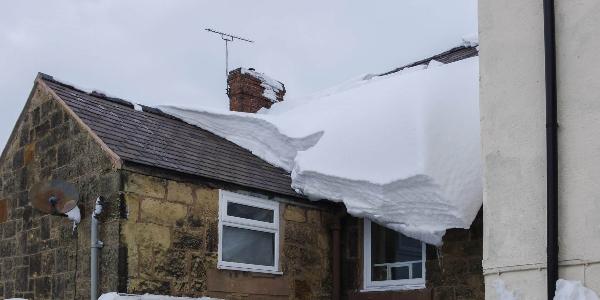Winterize your company with these best practices!

By Dani Sheehan.
The weather may be unpredictable but that doesn’t mean you can’t be prepared. Find new ways to expand your services and take on more projects this upcoming winter season.
With each changing season, homeowners are increasingly reminded of the effects of harsh weather conditions on their home. From heavy snowfall and ice dams to freezing temperatures and high winds, winter can take a toll on roofs, leading to costly repairs if not properly prepared. You can play a key role in protecting your customers’ homes by helping them prepare for the winter months.
Staying ahead of the incoming weather not only helps safeguard homes but it also ensures business continuity during colder months. One way to help you streamline this process and keep normal operating hours throughout winter is with RoofSnap. Known for its speed and accuracy, RoofSnap provides the fastest roof and gutter measurements in the industry, allowing you to quickly assess roofs and offer reliable estimates without braving the elements.
By leveraging RoofSnap, you can respond swiftly to project inquiries and help homeowners prepare their roofs for winter with confidence.
Help your customers prepare their roofs for winter
1 – Conduct roof inspections. Before the first snowfall, encourage homeowners to schedule a comprehensive roof inspection. Make sure you have a checklist to cover all critical aspects of the roof. Check for any damaged or missing shingles, as well as all flashing around chimneys, vents and skylights. Also, check that gutters are clear of debris and properly attached.
2 – Build up your service department to offer repairs and maintenance. If you don’t already have a service department, consider offering common services such as shingle replacement and flashing repairs or gutter cleaning and debris removal. These are services that don’t require very much time on your part but can greatly extend the life of your customers’ roofs.
3 – Educate your customers on proper attic insulation and ventilation. One of the most common winter roofing issues is the formation of ice dams, which occur when heat escapes from the attic, melting snow on the roof. The water then freezes at the eaves, creating a barrier that prevents proper drainage and can allow water to infiltrate the home.
Installation and safety tips for winter
1 – Understand limitations and temperature-dependent materials. Certain materials are hardier than others in cold climates. Slate, metal and asphalt shingles typically withstand freezing temperatures and extreme weather conditions better than other materials. For example, EPDM requires specific procedures to be properly installed in the winter. Think about what projects you can take on in the winter to be the most efficient and avoid weather delays.
2 – Choose the right underlayment. What goes under your roofing material is just as important as the roofing material itself. Take time to find the perfect solution for the weather and give your homeowners peace of mind that the underlayment will protect the rooftop if the weather does delay finishing installation.
3 – Your crew’s safety comes first. It may seem obvious but work with your crew to brush up on safety concerns associated with colder temperatures. Encourage them to travel safely to and from jobsites and remember that if a road is icy, a roof may be icy as well. Dehydration is also just as big of a concern in the winter as it is in the summer – workers doing heavy work often sweat beneath layers of heavy clothing without noticing. Finally, guard against hypothermia and frostbite by wearing the appropriate clothing, including gloves, warm socks, boots and several layers. Take frequent breaks to warm your core temperature and ensure extremities aren’t exposed to frigid temperatures for too long.
Learn more about RoofSnap in their Coffee Shop Directory or visit www.roofsnap.com.
About Dani
Dani is a writer for The Coffee Shops and AskARoofer™. When she's not writing or researching, she's teaching yoga classes or exploring new hiking trails.






















Comments
Leave a Reply
Have an account? Login to leave a comment!
Sign In